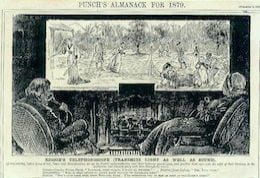17th Jan 2018 5:30pm-7:00pm
Edward Street 102
Professor Iwan Rhys Morus ( Aberystwyth University)
In a short story published in the Century Magazine in 1898 Mark Twain entertained his readers with a glimpse of the near future. “From the London Times of 1904” offered a tale of murder and botched justice constructed around a wonderful new instrument – the telectroscope. This was a device that could transmit vision, just as Alexander Graham Bell’s telephone, invented just over twenty years earlier, transmitted sound. Rumours about this kind of technology had in fact been circulating ever since the announcement of Bell’s invention at the Centennial Exhibition in Philadelphia. It offers a fascinating instance of a technology that was always on the brink of being realized: no telectroscope was ever made as a matter of fact, and accounts of the invention are now usually treated as parts of the prehistory of television. In this paper I want to take a different tack and look at the telectroscope as an instance of the future in the making. The final decades of the nineteenth century were a period of intense speculation about the ways in which new technologies would reconfigure the future. Drawing on research carried out as part of the AHRC-funded Unsettling Scientific Stories project I will treat the telectroscope as part of the material and imaginative culture of Victorian futurism and discuss what it shows us about the ways such futures were made.
Iwan Rhys Morus is professor of history at Aberystwyth University. He is the editor of the recently published Oxford Illustrated History of Science and the author of a number of books on the cultural history of Victorian science including William Robert Grove: Victorian Gentleman of Science (UWP, 2017), Michael Faraday and the Electrical Century (Icon Books, 2017) and Shocking Bodies: Life, Death and Electricity in Victorian England (History Press, 2011).


Leave a Reply